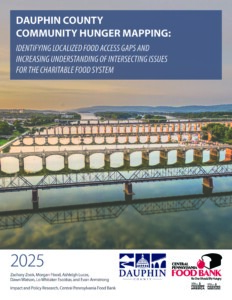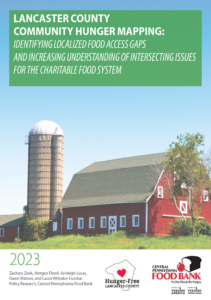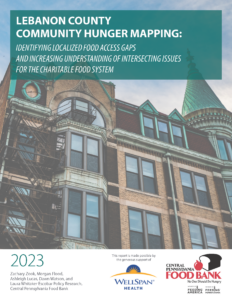Impact and Policy Research
Recent Work
Franklin County Hunger Mapping
In 2023, one in eight residents of Franklin County shouldered the heavy weight of not knowing from where their next meal would come. In total, nearly 19,000 people were food insecure in the county; of these, almost 5,600 were children. The burden of food insecurity is not evenly spread across the county. Though it weighs upon citizens of every municipality and neighborhood across the county, the degree to which it does varies based upon geography, demographics, and many other factors.
This Community Hunger Mapping Report aims to understand the dispersion, experience, and causes of food insecurity across and within Franklin County. Community-engaged research methods were used to depict the food insecurity landscape and the charitable food network’s response to it with detail, nuance, and compassion. Specific emphasis is placed upon highlighting the perspectives of neighbors experiencing food insecurity as expressed through surveys conducted at food pantries and other community resources across the county, as well as semi-structured one on one interviews.
To learn more about the 2025 Franklin County Community Hunger Mapping Report’s findings and recommendations, please see the Executive Summary or the Full Report.

Dauphin County Hunger Mapping
More than 32,000 residents of Dauphin County face food insecurity as of Feeding America’s most recent Map the Meal Gap estimates. Of these food insecure residents, two in five are children, and one in three lives within Harrisburg city limits. The burden of not knowing from where the next meal will come weighs upon every neighborhood and municipality across the county; however, this burden is unevenly spread across the county and its citizens depending on demographics, geography, and a host of other factors.
This Community Hunger Mapping report seeks to more deeply understand the dispersion, experience, and root causes of food insecurity across and within Dauphin County in a detailed, nuanced, and compassionate manner. To depict the landscape of food insecurity and the charitable food network’s response to it, this report centers the thoughts of neighbors experiencing food insecurity as gathered through surveys conducted at food pantries and other community resources throughout the county as well as one-on-one interviews. As part of a unique analysis designed for this report, several interviews were conducted on site at soup kitchens to better understand the experiences of unhoused individuals who interact with the charitable food system..
To learn more about the 2025 Dauphin County Hunger Mapping Report’s findings and recommendations, please see the Executive Summary or the Full Report.

SUN Region Hunger Mapping
One in eight (12.5%) individuals in Snyder, Union, and Northumberland counties (the SUN region) faces food insecurity. In total, more than 22,000 residents of the SUN region did not know where their next meal would come from in 2022. About 5,000 of these individuals had not been food insecure in 2021.
Food insecurity exists in every municipality in the SUN region, but food insecurity has an uneven impact based on geography and demographic factors such as race, ethnicity, age, disability status, and household type. This report seeks to understand the distribution and experience of food insecurity across these counties as well as its drivers and root causes.
To learn more about the 2024 SUN Region Hunger Mapping Report’s findings and recommendations, please see the Executive Summary or the Full Report.
Lebanon County Hunger Mapping
One in ten (9.8%) Lebanon County residents experiences food insecurity, and a similar proportion (9.7%) visited a food pantry in the last year. In total, nearly 14,000 individuals in the county are impacted by food insecurity and the charitable food network’s response to it. Importantly, food insecurity does not impact people of all ages, household types, geographies, or race/ethnicities equally. With this understanding, this report assesses the causes and distribution of these differences and discusses ways stakeholders can work to reduce these inequities.
Given a problem of this breadth and complexity, it is critically important for stakeholders in the charitable food network to better understand the issues at play. This report aims to provide that understanding and to chart a path forward to reducing food insecurity in the near and long-term.
To learn more about the 2024 Lebanon Community Hunger Mapping Report’s findings and recommendations, please see the Executive Summary or the Full Report.
Lancaster County Hunger Mapping
Nearly 50,000 people in Lancaster County face food insecurity, meaning that a staggering one in eleven Lancastrians experiences limited or uncertain access to adequate food throughout the year. Food insecurity is an unacceptable problem anywhere, but it is especially intolerable in a community as abundant as Lancaster.
To that end, this Community Hunger Mapping report is the charitable food system’s first major research initiative to better understand the causes, experiences, and dispersion of food insecurity in the county, as well as to make actionable recommendations that can improve neighbor experience at pantries in the immediate future and can begin to eliminate hunger in Lancaster County in the long term.
To learn more about the 2023 Lancaster Community Hunger Mapping Report’s findings and recommendations, please see the Executive Summary or the Full Report.

Previous Publications
We value integrity, inclusivity, and transparency in all our endeavors. Our team is committed to engaging with diverse perspectives and advocating for policies that address the unique challenges faced by vulnerable populations, including marginalized communities and underserved individuals. By amplifying the voices of those directly impacted by food insecurity, we work towards building a fairer and more resilient society where no one has to endure hunger or food insecurity.


